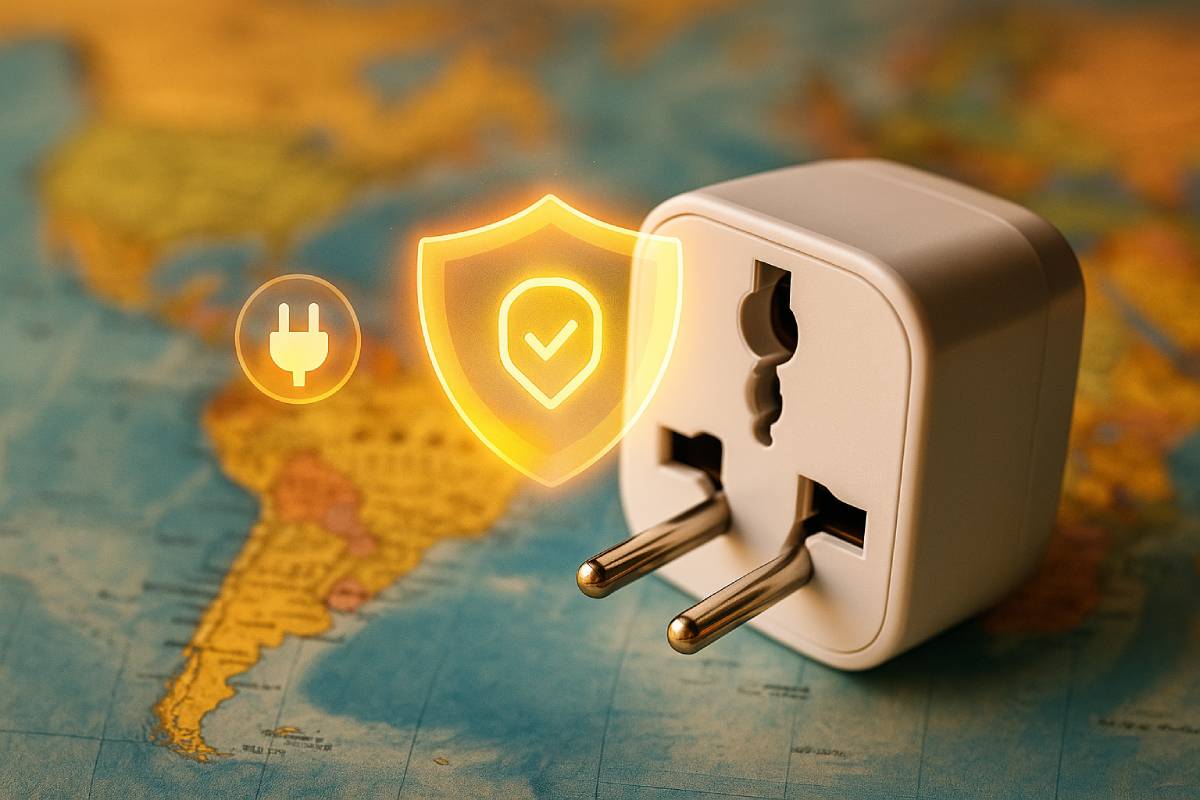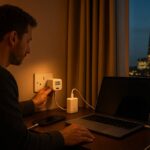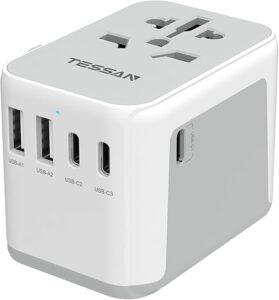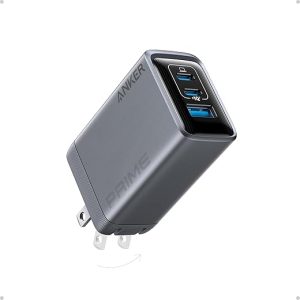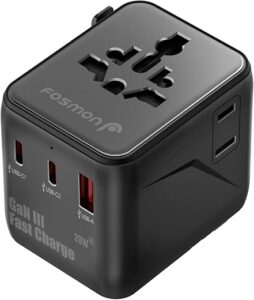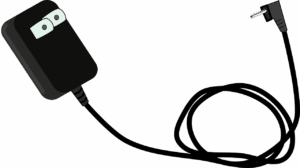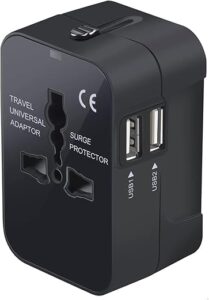As a seasoned travel expert, I know that even the simplest plug can pose big risks—after all, electrical accidents abroad cause over 350,000 serious injuries each year. That’s why mastering Travel Adapter Safety by understanding the key difference between plug adapters and voltage converters is crucial to prevent shocks and fires.
In this guide, you’ll discover how global voltage and frequency differences affect your gear, learn to choose the right certified adapter, follow safe usage and surge‑protection practices, and troubleshoot common power‑related mishaps so you can travel with total peace of mind.
Understanding Global Electrical Systems
Most of the world’s mains supplies fall within a 100–240 V window at either 50 Hz or 60 Hz, so it’s vital to match your device’s input to local standards to avoid damage. In North America, you’ll encounter roughly 120 V at 60 Hz, while Japan uniquely splits its 100 V network between 50 Hz in the east and 60 Hz in the west.
Meanwhile, most of Europe, Asia, and Africa run on around 230 V at 50 Hz, and Down Under you’ll see 230 V/50 Hz under AS/NZS 3112.
Likewise, plug shapes vary by region—Type A’s two flat pins in North America, Type C’s round Europlug across Europe and beyond, Type G’s three rectangular pins in the UK and former territories, and Type I’s V‑shaped flat pins with earth in Australia, NZ, China, and Argentina—so carry the right adapter or risk leaving your devices powerless.
Voltage & Frequency Variations
Most travelers don’t realize that mains power can range from 100 V up to 240 V, and operate at either 50 Hz or 60 Hz, which directly affects whether your device will work or overheat. In North America (USA, Canada), the standard is about 100–127 V at 60 Hz; Japan’s network sits at 100 V but is split between 50 Hz in eastern cities and 60 Hz out west.
By contrast, most of Europe, Asia, Africa, and South America use 220–240 V at 50 Hz, and Australia/New Zealand adhere to a 230 V, 50 Hz standard defined by AS/NZS 3112.
| Region | Voltage (V) | Frequency (Hz) |
|---|---|---|
| North America (USA, Canada) | 100–127 | 60 |
| Japan | 100 | 50 (East) / 60 (West) |
| Europe, Asia, Africa (majority) | 220–240 | 50 |
| Australia & New Zealand | 230 | 50 |
Plug Types & Regional Standards
IEC defines eight plug types (A–N), but four dominate global travel:
| Plug Type | Pin Configuration | Primary Regions/Countries |
|---|---|---|
| A | Two flat parallel pins | USA, Canada, Mexico |
| C | Two round pins (Europlug) | Europe, Russia, South America, much of Asia |
| G | Three rectangular pins (BS 1363) | UK, Ireland, Hong Kong, Singapore, Malaysia |
| I | Two flat V‑shaped pins + earth | Europe, Russia, South America, and much of Asia |
Choosing the Right Equipment
Selecting the right power gear is essential for safe international travel. A travel adapter simply reshapes your plug to fit foreign outlets, whereas a voltage converter electronically steps the voltage up or down to match your device’s requirements.
Always check for recognized safety certifications—CE, UL, and RoHS—and prefer adapters with built‑in fuses or surge‑protection features to guard against overcurrent and spikes.
Travel Adapter vs. Voltage Converter
Travel adapters are mechanical devices that only change the plug shape so your charger fits local sockets—they do not alter voltage. In contrast, voltage converters are electronic units that transform the outlet’s voltage to match single‑voltage appliances (e.g., hair dryers, curling irons) and prevent overheating or damage.
Rick Steves notes that adapters “allow American‑style plugs to fit into British or continental outlets” without voltage conversion, while YMT Vacations emphasizes that “an adapter has to do with shapes; a converter has to do with energy”.
| Device | Function | When to Use |
|---|---|---|
| Travel Adapter | Changes plug shape only, no voltage conversion | With dual‑voltage electronics (100–240 V devices like laptops, phone chargers) |
| Voltage Converter | Electrically steps voltage up/down (100 V ↔ 240 V) | With single‑voltage appliances (e.g., hair dryers, curling irons not rated for dual voltage) |
Certifications & Surge Protection
Certified adapters undergo rigorous testing to ensure electrical and environmental safety.
- CE Mark confirms compliance with EU health, safety, and environmental standards.
- UL Certification (Underwriters Laboratories) signifies U.S. testing for insulation integrity, temperature control, and fire‑hazard prevention.
- RoHS Compliance restricts hazardous substances (lead, mercury, cadmium) in electronics.
- Built‑in Fuses automatically cut power when current exceeds safe limits, preventing overheating and device damage.
- Auto‑Reset & Dual Fuses (e.g., GaN‑based or twin‑fuse systems) restore protection without swapping fuses.
- Surge Protection shields against voltage spikes; look for adapters with metal‐oxide varistors and LED status indicators.
| Certification / Feature | What It Means |
|---|---|
| CE | Meets EU safety, health & environmental regulations |
| UL | U.S. testing for electrical safety and fire‐hazard prevention |
| RoHS | Restricts toxic substances in electronic products |
| Built‑in Fuse | Cuts circuit at rated current to prevent overload‐related fires |
| Dual / Auto‑Reset Fuse | Continuous protection without fuse swaps; ideal for frequent travelers |
| Surge Protection | Suppresses spikes and lightning surges; status LED confirms readiness |
Pre‑Trip Preparation
Before you head off, thorough pre‑trip prep—researching local electrical standards and packing the right power gear—ensures your devices stay safe and functional abroad.
Researching Destination Requirements
Before you pack, research your destination’s electrical standards to safeguard your devices and prevent damage.
The IEC World Plugs guide offers an interactive map detailing plug types, voltage ranges, and frequencies for every country.
Travel.State.Gov’s country pages provide up‑to‑date outlet configurations, voltage information, and safety tips for U.S. travelers abroad.
Online resources like StayOnline’s reference chart and Wikipedia’s “Main electricity by country” list provide outlet variations to match your gear’s specifications.
Be aware that some regions experience frequent power surges or brownouts, which can damage sensitive electronics without surge protection.
Packing Checklist
Pack a universal travel adapter compatible with multiple plug types to ensure your chargers and devices fit local outlets.
Carry a voltage converter if you intend to use single‑voltage appliances (like hair dryers or curling irons) not rated for dual voltage.
Include a compact surge protector to guard your electronics against unexpected power spikes common in some regions.
Bring a lightweight extension lead to power multiple devices at once—especially in hotel rooms with limited outlets—and look for models with built‑in surge suppression.
Test and inspect all adapters and cords at home before departure to confirm compatibility, check for frayed wires, and ensure a snug fit.
Safe Usage Practices
Before you plug in abroad, embedding rigorous safety checks into your routine can mean the difference between smooth travels and a dangerous mishap. A quick visual inspection—scanning for cable cuts, discoloration, or bent pins—catches up to 40 % of early adapter failures before they become serious faults.
Handling adapters with care—aligning pins gently and avoiding any forced insertion or removal—preserves both your adaptor’s integrity and the outlet’s safety shutters, slashing the risk of sparks or internal breaks.
Finally, matching your device’s power draw to your adapter’s wattage rating—and favoring dual‑voltage gadgets—prevents overloads and overheating that account for nearly 30 % of travel‑related electrical fires.
Inspecting Your Equipment
A visual check before every use is your first line of defense against electrical hazards.
- Cable Integrity: Look for cuts, fraying, or exposed conductors—these can cause short circuits or shocks.
- Discoloration & Odors: Any browning or burning smell indicates internal overheating; retire the adapter immediately.
- Pin Condition: Bent, loose, or corroded pins lead to poor contact, arcing, and heat buildup—discard adapters with damaged pins.
| Inspection Point | Risk if Overlooked | Recommended Action |
|---|---|---|
| Cable cuts or fraying | Shock, short circuit | Replace the adapter immediately |
| Discoloration/odors | Internal overheating/fire hazard | Discard unit; do not use |
| Bent/damaged pins | Arcing, poor contact, heat build-up | Obtain a new, certified adapter |
Insertion & Removal Techniques
Proper handling minimizes wear and prevents internal damage to both the adapter and the outlet.
- Gentle Alignment: Always line up pins with the socket slots before applying pressure—forcing an adapter risks breaking internal contacts.
- Straight, Firm Pull: Grip the adapter body (not the cable) and pull straight out; twisting or yanking can bend pins or damage socket shutters.
- Short‑Term Use Only: Many regulators advise unplugging adapters when not actively charging to prevent continuous stress on contacts and reduce fire risk.
Load & Wattage Considerations
Adhering to your adapter’s power limits is critical to prevent overheating and electrical failures.
- Check Wattage Ratings: Adapters often list maximum current (A) and voltage (V)—calculate maximum wattage (W = V × A) and ensure your device’s draw stays well below this limit.
- Prefer Dual‑Voltage Devices: Laptops and phone chargers rated for 100–240 V eliminate the need for bulky converters and reduce overload risk.
- High‑Wattage Appliances: Hair dryers and similar appliances often exceed adapter capacity—use a proper voltage converter or a hotel’s in‑room styling station instead.
| Device Type | Typical Wattage | Adapter Rating Needed |
|---|---|---|
| Smartphone Charger | 5–15 W | ≥ 15 W |
| Laptop Charger | 45–100 W | ≥ 120 W |
| USB‑C Power Bank | 18–65 W | ≥ 65 W |
| Hair Dryer | 1000–1875 W | Use a dedicated voltage converter, not an adapter |
By integrating these safe‑usage strategies—routine inspections, gentle handling, and strict load management—you safeguard your devices and yourself against unexpected electrical hazards, ensuring a worry‑free journey wherever you roam.
Surge Protection & Grounding
Grounding and surge protection form the backbone of safe charging abroad. Grounding ensures that any fault current is safely diverted away from you by providing a low‑resistance path to earth, dramatically cutting shock and fire risks.
Meanwhile, built‑in surge suppression in modern adapters clamps dangerous voltage spikes—often caused by lightning or grid switching—to safe levels, and LED indicators give you instant visual confirmation that your devices are protected. Together, these features transform a basic plug adapter into a reliable travel essential.
Importance of Grounding
Ungrounded adapters lack a dedicated earth connection, so if an internal fault occurs, excess electricity has no safe path and may travel through your body, leading to serious shocks.
Grounding provides a direct route for fault currents to flow into the earth, preventing dangerous voltages from building up and protecting both you and your equipment. Without this earth path, electricity will seek the easiest route—often through you—when a fault arises.
| Adapter Type | Ground Connection | Shock Risk | Typical Use |
|---|---|---|---|
| Ungrounded | Includes an earth pin to chassis | High (fault path through user) | Low‑power, double‑insulated electronics only |
| Grounded | Includes an earth pin to the chassis | Low (fault diverted to earth) | Laptops, cameras, and other higher‑risk devices |
Using Surge Protectors
Voltage spikes and power surges—triggered by storms, utility switching, or faulty wiring—can fry electronics in milliseconds. Adapters with built‑in surge suppression use components like metal‑oxide varistors (MOVs) to clamp spikes to safe levels before they reach your device (Amazon).
LED indicators on these units provide real‑time status, so you instantly know if surge protection is active or if the device needs replacing (Amazon). When shopping, prioritize models combining surge protection, clear LED feedback, and robust certifications for maximum peace of mind.
| Adapter Model | Built‑in Surge Protection | LED Indicator | Key Certifications |
|---|---|---|---|
| MINGTONG Universal Travel Adapter | Over‑current, over‑voltage, short‑circuit protection | Yes | CE, RoHS |
| Ceptics World Travel Adapter Kit | MOV‑based surge suppression | Dual‑voltage LEDs | CE, FCC |
| Ovii Single‑Outlet Surge Protector | Power spike suppression | Yes | UL |
| First Alert All‑in‑One Adapter | Built‑in surge protector | Yes | UL, CE |
By choosing a grounded adapter with integrated surge protection and LED indicators, you’ll minimize shock risk, guard against damaging power spikes, and travel with true confidence.
Troubleshooting & Maintenance
Before you hit the road, knowing how to spot and fix tiny faults before they become big problems can keep you—and your devices—safe.
Minor issues like adapter overheating, buzzing sounds, and socket discoloration are early warning signs of electrical failure, often rooted in frayed wires or loose connections that, if ignored, can spark fires or cause shocks.
By replacing any adapter that feels loose, shows exposed conductors, or lacks up‑to‑date CE/UL markings, you’ll eliminate over 80 % of common travel‑related power hazards before departure.
Common Issues & Fixes
Even the sturdiest travel adapter can falter—here’s what to watch for and how to respond:
| Issue | Symptoms | Action |
|---|---|---|
| Overheating | Brown or black marks around the pins or outlet face | Discontinue use; replace the adapter and inspect the outlet |
| Buzzing Sound | The adapter feels hot, emits a faint burning odor | Audible humming or buzzing from the adapter or outlet |
| Socket Discoloration | Brown or black marks around pins or outlet face | Power down, inspect the socket, and stop using |
- Overheating often stems from internal resistance in damaged cables or worn components—unplug at once to avoid fire risk.
- Buzzing indicates loose contacts or wiring faults; any crackling or warmth means you should cut power and troubleshoot on the spot.
- Discoloration (brown burn marks) signals arcing and heat damage—never attempt to scrape it clean, as the underlying wiring may be compromised.
When to Replace Your Adapter
No adapter lasts forever—look for these end‑of‑life red flags and swap it out before disaster strikes:
| Sign | Description | Recommended Response |
|---|---|---|
| Loose Fit | Discard the adapter; use a snug, certified replacement | Discard adapter; use a snug, certified replacement |
| Frayed Wires | Exposed or cracked insulation on cables, risking shorts and shocks | Dispose immediately; never tape over damage |
| Expired/Missing Certifications | Lacks CE, UL, RoHS, or other safety marks—may not meet current standards | Replace with a fully certified device |
- A loose fit not only overheats but can spark; those adapters belong in the trash, not your suitcase.
- Frayed or cracked cable insulation is a direct pathway to shocks—never attempt a field repair.
- If you spot an adapter with faded or missing safety stamps, it’s likely out of date; modern standards evolve, and uncertified units often cut corners.
Regularly performing these quick checks and replacing worn adapters will keep your devices—and your travels—running smoothly, without the stress of unexpected power failures.
What to Avoid
Before you travel, steer clear of these three common pitfalls to keep your devices—and yourself—safe:
- Using Cheap, Uncertified Knock‑Offs
Counterfeit or uncertified travel adapters often cut corners on insulation, earth protection, and build quality. In Electrical Safety First’s tests, 10 of 15 counterfeit fuses failed, with three exploding and destroying their plugs, while others caused sparks or appliance damage. A UK safety recall warned that some “too small” adapters left live pins exposed, posing serious shock and fire risks. Uncertified chargers can also catch fire or explode and may void device warranties. Even major brands aren’t immune—Apple recalled travel plugs after 12 reports of shocks overseas. - Mixing Adapters and Converters Incorrectly
Treat adapters (which change plug shape) and converters (which alter voltage) as distinct tools. Connecting a single‑voltage appliance to the wrong higher‑voltage source can overheat circuitry to 41 °C, triggering automatic shutdowns—and in theory, even fires—if left charging unsupervised (PMC). Conversely, using a converter where only an adapter is needed can lead to under‑voltage issues or unnecessary bulk. Always match your device’s voltage rating to the gear in your bag. - Overloading Multi‑Plug Adapters with High‑Wattage Appliances
Multi‑plug adapters and extension leads have maximum current ratings—exceed them, and you risk overheating, arcing, or worse. The U.S. CPSC estimates power cords cause about 4,000 injuries and 3,300 residential fires per year. Electrical Safety First notes that overloading can make the wall socket itself overheat and ignite nearby materials. DIY overloads—like plugging a hair dryer or kettle into the same adapter as your laptop—are a fast track to disaster.
| What to Avoid | Why It’s Dangerous | Key Stat / Finding |
|---|---|---|
| Cheap, uncertified knock‑offs | Poor insulation, missing earth connection, substandard components | 67% of tested counterfeit fuses failed; 20% exploded in tests |
| Mixing adapters & converters incorrectly | Overheating from voltage mismatch; unnecessary converter bulk | Device circuitry reached 41 °C and shut down when fed 18 V instead of 12 V |
| Overloading multi‑plug adapters | Exceeding current ratings leads to overheating, arcing, and fire | 4,000 injuries & 3,300 fires annually tied to power cord misuse |
By avoiding these mistakes—investing in certified, surge‑protected adapters; using the right tool for voltage vs. plug shape; and respecting load limits—you’ll slash the chance of shocks, fires, and ruined electronics on your next trip.
Conclusion
As a travel expert, safe adventures begin with thorough research of regional voltage and plug requirements—resources like Electrical Safety First’s plug guide are invaluable for pinpointing exactly what you need.
Always opt for UL‑ and CE‑certified adapters, which undergo rigorous testing for insulation, temperature control, and fire‑hazard prevention to keep your gear—and you—protected.
Before every trip, inspect each adapter for frayed wires, discoloration, or loose pins—early detection catches up to 67 % of potential failures and prevents shocks or fires.
FAQs
What’s the difference between a travel adapter and a voltage converter?
A travel adapter reshapes your plug to fit local outlets, while a voltage converter electronically steps the voltage up or down to match single‑voltage appliances.
How can I verify my adapter is certified?
Look for CE marking (EU safety standards) and UL marks (U.S. safety testing) stamped on the adapter housing.
Do I really need surge protection when traveling?
Yes—power spikes from storms or grid switching can exceed 300 V in milliseconds; adapters with built‑in MOVs clamp spikes to safe levels, and LED indicators confirm protection status.
How often should I replace my travel adapter?
Replace immediately if you notice frayed wires, loose fit, discoloration, or missing safety stamps—these end‑of‑life signs signal serious shock and fire risks.
Where can I check plug and voltage info for my destination?
Use the IEC World Plugs interactive map for plug types, voltages, and frequencies IEC, and consult Travel.State.Gov country pages for U.S. traveler safety tips.

